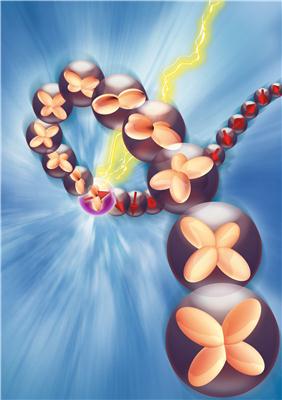Physicists from Paul Scherrer Institute (PSI) in Switzerland and the IFW Dresden in Germany have observed the breakdown of an electron into two new particles inside a solid.
 Artist's impression of an electron splitting up into two new particles: a spinon carrying the electron's spin and an orbiton carrying its orbital moment.
Artist's impression of an electron splitting up into two new particles: a spinon carrying the electron's spin and an orbiton carrying its orbital moment.
The particles are an orbiton, which emerges from the movement of an electron around the nucleus and a spinon, which makes the electron to act as a tiny compass needle. These particles remain inside the material in which they are created.
Researchers have made the observation of the two new particles from measurements on Sr2CuO3, a copper-oxide compound. This material includes unique features that allow the particles to move only in a single direction, either forward or backward. The team has used X-rays from the Swiss Light Source (SLS) to energize some of the electrons that belong to the copper atoms in Sr2CuO3. The process has resulted in the break-up of the electrons into two parts: the orbiton with higher orbital moments and the spinon with the electron's spin.
The head of the experimental team from PSI, Thorsten Schmitt, stated that the experiment requires very powerful X-rays with an exceptionally well-defined energy to create an effect on the electrons present in the copper atoms of the material and in addition, the study needs high-precision X-ray detectors. The examination of the electron split-up may have a major impact on another research area, high-temperature superconductivity. By understanding the process of electrons decaying into other forms of particles in copper-based superconductors may enhance the theoretical knowledge of high-temperature superconductivity.